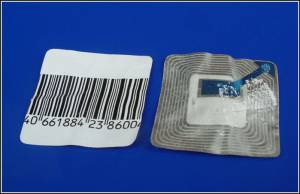Radio Frequency Identification Devices (RFID) are widely being hailed as the up-and-coming successor to barcodes. The superiority of RFID lies in its faster speed, rewriting capabilities, and the fact that the device need not be visible to be read. However, until the cost of RFID is lowered, barcodes will remain the prevalent technology. RFID works through a two-part system – the system scanner communicates with the tag through its antenna. This tag can be active or passive, battery-powered or powered by the signal received – both types contain read-only memory, but only active devices are rewritable. This technology has many current and future applications in retail, including the maintenance of a timely inventory and the tracking of traveling items.
Introduction
Imagine going shopping the week before Christmas. What probably comes to mind are overcrowded stores, impatient shoppers and long checkout lines. Waiting in these lines can be tiring and frustrating. Now imagine a situation in which you put the items you wish to purchase in your shopping bag and simply exit the store. No, this is not a fictional society in which shoplifting is permitted. Rather, without even opening your bag, the appropriate amount of money is deducted from your bank account. You do not have wait while the cashier picks up each item, looks for the barcode, and scans it.
Does this sound too good be true? While this may sound like something from a futuristic movie, such technology already exists in the form of Radio Frequency Identification devices (RFID). Though not yet widespread, these devices may be as common as barcodes in a few years.
In this article, we compare RFID to barcodes and explore how different radio frequency identification devices work, underlining the difference between active and passive devices. By providing scenarios in which RFID is currently being used, we shall illustrate its implications for our lives in the future.
RFID vs. Barcodes
The first barcode was used on a pack of Wrigley’s Juicy Fruit Gum in 1974. Since then, barcode use has spread to retail items, letters, packages, chemical containers, security badges, and coupons.
The most common use of barcodes is in retail; barcodes are present on nearly every retail product in the United States, used to hasten the processes of taking inventory and checking out [1]. Barcodes are also very cost effective. They save hours of time at a low cost: each scan costs only five cents [2].
While barcodes are extremely useful, they have two main limitations. The first is that only one barcode can be scanned at a time. Secondly, the barcode must be within the direct line of sight of the scanner. For instance, the barcode cannot be read from within a shopper’s bag or if covered with dirt. Nor can it be read if fog, dust, or any other condition restricts visibility.
In terms of use, the RFID is similar to a barcode (Fig. 1). The RFID tag contains binary information that is scanned by a reader. While an RFID tag is currently more expensive than a barcode label, it lacks the problems associated with barcode. Scanning one barcode takes 1 to 2 seconds, while scanning an RFID tag takes less then 2/100 of a second – thus, RFID is approximately 100 times faster than barcode technology.
When many tags are scanned together, the reader scans all the tags present and looks for those with lower numbers first. For instance, it will read the tags that begin with zero before those that begin with a one. This prevents the signals of multiple tags from being confused with one another. Through this process, a reader can read as many as 50 tags per second [3].
Another advantage of RFID is that a reader does not need a clear line-of-sight to read a tag. The signal through which the reader and RFID tag communicate can penetrate solid material. Thus, the tag can be read, even when inside a container.
What is an RFID?
An RFID system consists of two separate components: a tag and a reader. Tags are analogous to barcode labels, and come in different shapes and sizes. The tag contains an antenna connected to a small microchip containing up to two kilobytes of data.
The reader, or scanner, functions similarly to a barcode scanner; however, while a barcode scanner uses a laser beam to scan the barcode, an RFID scanner uses electromagnetic waves. To transmit these waves, the scanner uses an antenna that transmits a signal, communicating with the tag’s antenna [4]. The tag’s antenna receives data from the scanner and transmits its particular chip information to the scanner.
The data on the chip is usually stored in one of two types of memory. The most common is Read-Only Memory (ROM); as its name suggests, read-only memory cannot be altered once programmed onto the chip during the manufacturing process. The second type of memory is Read/Write Memory; though it is also programmed during the manufacturing process, it can later be altered by certain devices [5].
Active Devices
Power must be provided to the chip so that it can re-transmit data. Depending on where the necessary power comes from, RFID devices are divided into two main categories – active and passive. An active device has a built-in battery that powers the tag and enables it to transmit data to the scanner [4].
The size of an active RFID device is often dictated by size of the battery, which ranges from smaller than a matchbox to the size of a brick. Battery size also determines the range over which the antenna can transmit data, which varies from a few feet up to one hundred feet. These devices often have up to one million bytes or a megabyte of read/write memory that can be manipulated and altered [5].
The battery limits an active RFID’s shelf life. Certain types last up to 10 years, but most only last for about 1 year. The active RFID devices are also costly. The cheapest active tags cost a dollar apiece, and this steep price prevents them from competing with bar codes [5].
Passive Devices
Compared to active devices, passive RFIDs have unlimited shelf lives and can cost as little as 20 cents per tag, due to the absence of a battery. Therefore, the passive RFID tags can be as small as a grain of rice (Fig. 2) and much smaller than any active tag [5].
Passive devices are powered by the electromagnetic waves transmitted by the receiver. The receiver sends out energy in the form of an electromagnetic wave to the tag’s antenna. The passive tag then uses this signal’s energy to power the chip. While little power is produced in this way, it is sufficient to meet the needs of a small chip [4]. The amount of power provided to the tag restrains the amount of data that can be read. While the active tags hold up to one mega-byte of information, a passive tag generally contains a maximum of ninety-six bits [3].
Since the limited power available is not enough to write to a chip, passive RFID tags must use ROM memory. However, this is only a minor tradeoff when compared to the cost savings. Moreover, the relatively cheaper passive devices can be replaced if new data is necessary [5].
Current Applications
Due to its unique advantages, RFID technology already has wide applications. Since RFID lacks a line-of-sight requirement, it is well suited to the tracking of inventory. BMW Group South Africa uses RFID for this purpose. Long-range active RFID are employed, with readers placed in the warehouse. The readers regularly scan the room, comparing the results with the computer database. As trucks arrive or depart the warehouse, they are scanned to ensure that all parts have been loaded. Portable readers placed at other locations transmit data to the main warehouse database, thereby maintaining a running, up-to-date inventory [6].
RFID is also currently used in theft prevention, since a small RFID tag attached to an item may be scanned, even when concealed in a coat or bag. Simple RFID devices that look like a small coil of wire are placed on certain items, such as compact discs, for this purpose.
Another example is the “EZ pass” system used on some toll roads. The tag is placed in a car and the receiver is built above the designated toll lane. As the car passes beneath a receiver, the receiver scans the tag and automatically reduces the balance on the owner’s account [4].
RFID devices can also be used to sort items. Several airports, including the Denver International airport, use carts equipped with RFID tags to carry luggage through the airport terminals to the loading zone. Scanners are placed along the baggage route. As the scanners detect the carts, the system uses this information to track the luggage’s path and additionally control the conveyer belt intersections to ensure that the luggage ends up at the appropriate flight or baggage claim [6].
The Italian postal service uses RFID in a similar manner. RFID tags are attached to each mail bag being sent out. The tags are read as the bags are loaded and unloaded from planes. The system also helps track the approximate amount of time between pickup and delivery to ensure customer satisfaction [6].
Future Possibilities
As the production costs decrease, the use of RFID will continue to increase. According to the Auto-ID Center, up to 5,000,000,000 bar codes are scanned worldwide every day. Several companies, including Alien Technology Inc., are currently working on ways to manufacture tags that can be sold for five cents or less. At such a price, RFID can more viably compete with barcodes, and the industry will likely skyrocket [7].
Several companies, including Motorola Inc., are interested in correlating RFID tags with internet links. Suppose that you are comparing products from two different companies, and would like more information on which to base your choice. You pull out your web enabled PDA or cell phone that features a built in RFID receiver and use this to scan the product. The tag on the product transmits a code to your cell phone, which in turn accesses the internet. The company’s webpage pops up and shows you the detailed product specifications [8].
In another scenario, imagine yourself in a grocery store of the future. You walk up to a cash register, and all your items are instantaneously scanned – in the midst of this process, the supermarket automatically updates its inventory, and the system orders more of the items needed. On the factory floor, this order is received and another RFID system locates the items needed; once they are gathered and shipped out, an RFID system tracks the progress to ensure delivery to your local grocery store.
When you return home, you place your items in your refrigerator which also has a reader. The reader scans the items and logs the time that each item is placed inside. If you just purchased a gallon of milk, your fridge will be able to retrieve information regarding when and where it was bottled, the quality of dairy products from that region, what the best-before date is, and what temperature it should be kept at.
These are just a few of the possible applications that RFID technology offers. In the near future, RFID tags will likely become as common as barcodes, and interminable Christmas shopping lines may become a thing of the past.






